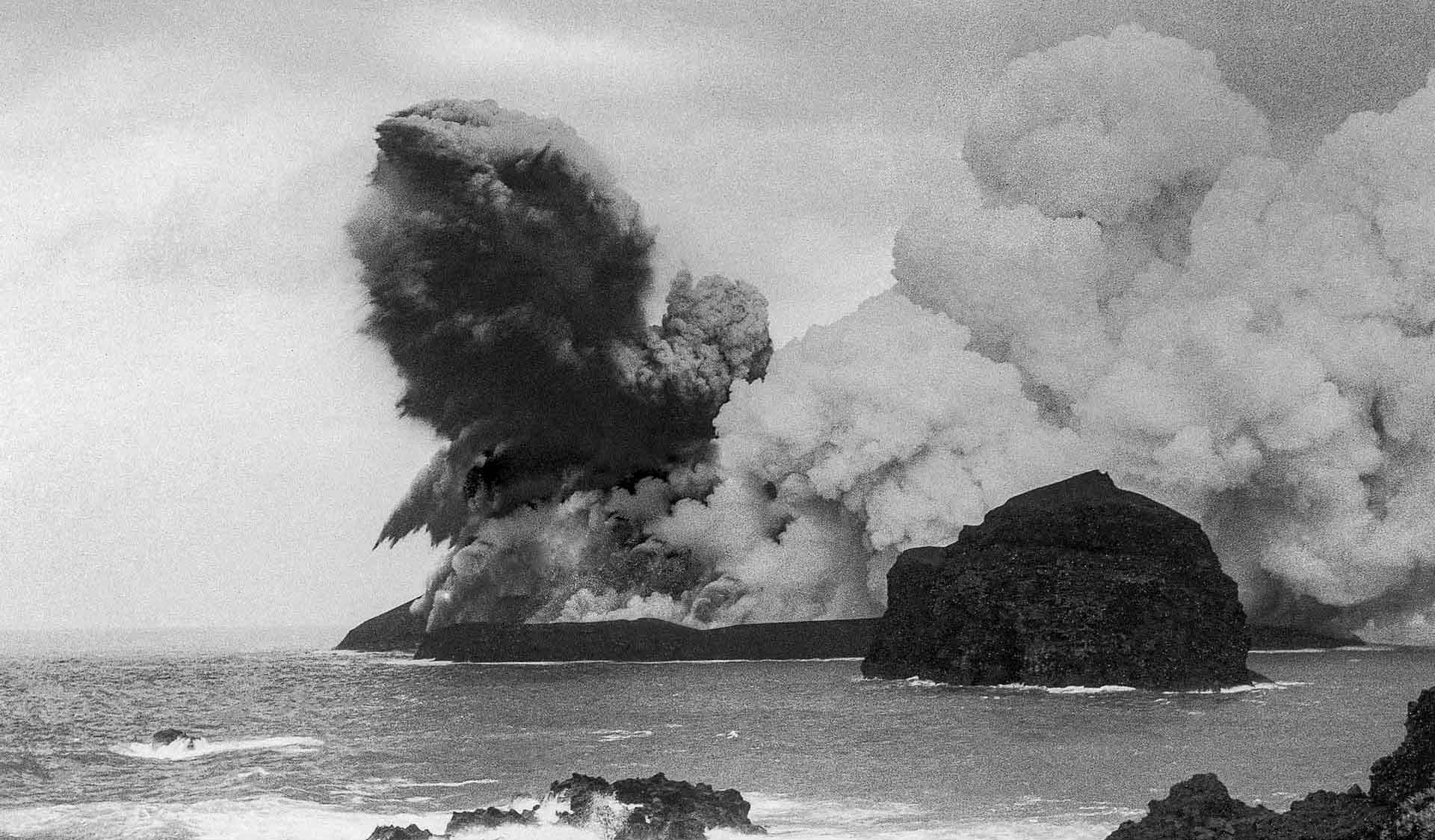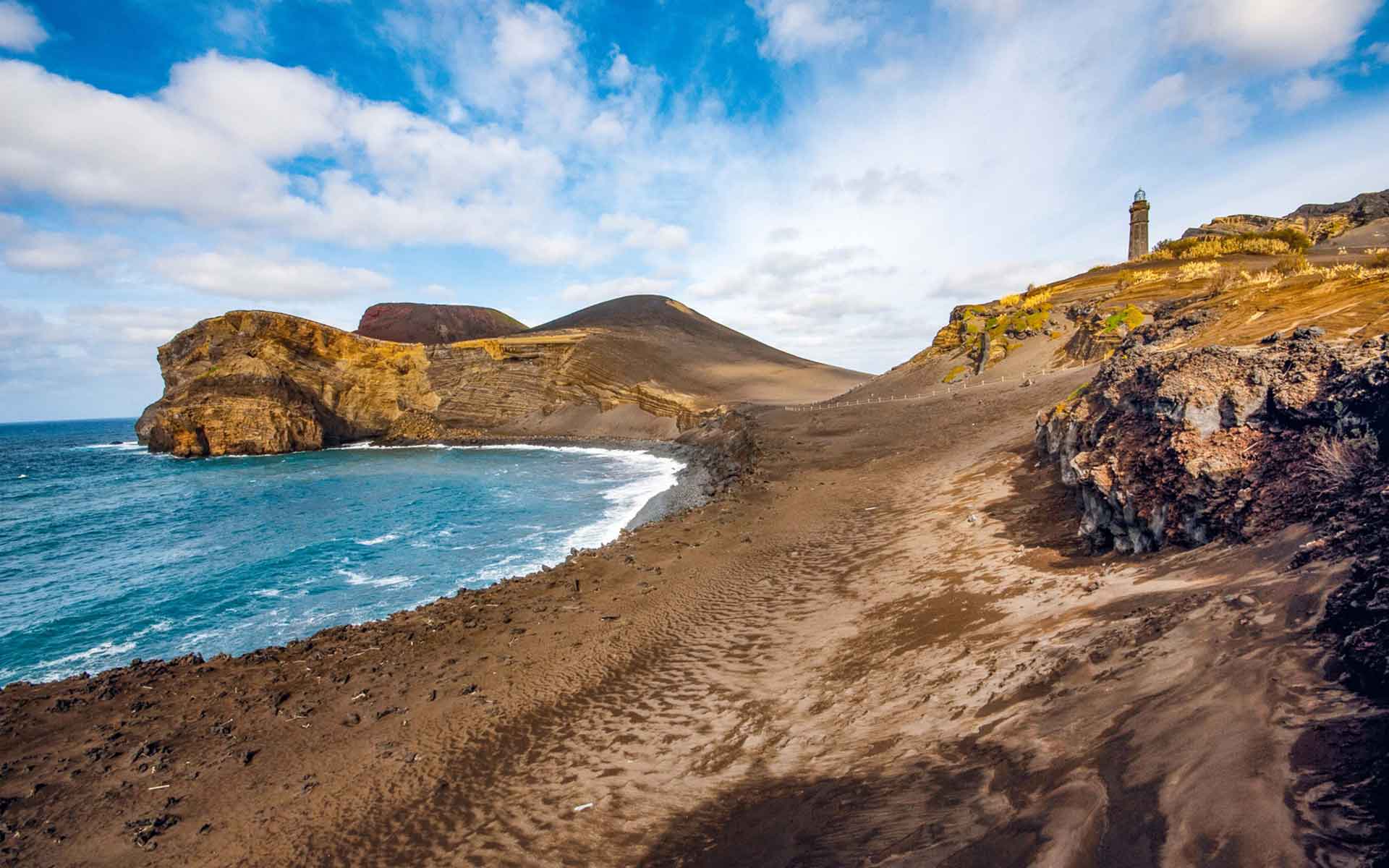
Picture taken on the early phase of the 1957-58 Capelinhos eruption, with the typical phreatomagmatic eruptions “cypress tree-like” ash jets and steam clouds.
Geological Period
Holocene. 1957/58
Main geological interest
History of geosciences
Volcanology
Location
Faial island, Azores Geopark, Portugal.
38°36’05.0″N, 28°49’53.0″W
Picture taken on the early phase of the 1957-58 Capelinhos eruption, with the typical phreatomagmatic eruptions “cypress tree-like” ash jets and steam clouds.
A historic, small submarine volcano that changed the world of volcanology.
The eruption of Capelinhos Volcano attracted the world’s attention due to its geological characteristics, location and study. It was the first submarine eruption in the world to be fully monitored and properly documented throughout its activity. Being so close to the shore and arousing the international scientific community’s curiosity (Tazieff, 1959; Waters and Fisher, 1971; Cole et al., 2001), Capelinhos became one of the best-documented phreatomagmatic volcanoes of the World (Sigurdsson et al., 2000). Those studies allowed new knowledge and opened a new page in the understanding of submarine volcanoes. The site is located in the Azores UNESCO Global Geopark.
- Geological description
This newly-born site results from a submarine volcanic eruption that started on 27 September 1957 and continued for the next 13 months, only 1 km away from Faial Island (Zbyszewski, 1960; Machado et al., 1962). It is the most recent of about 20 small monogenetic volcanoes along a tectonic alignment that contributed to the island’s formation and shape. The basaltic eruption started with the projection of volcanic ash accompanied by a large column of steam and volcanic gases. The accumulation of the tephra created a small islet that eventually connected to the island of Faial. The eruption then evolved to a subaerial style with the emission of scoria and lava flows. This eruption was accompanied by intense seismic activity that strongly affected the surrounding area. During the eruption, the volcano expelled around 174000000 m3 of volcanic material, covering the agricultural fields and adding 2.4 km2 to Faial Island – with only a fourth of this area remaining today due to sea erosion. The marks of this eruption remain, not only in the landscape but also in a cultural, social and economic frame. With the memory of the eruption, this surtseyan-type born tuff cone tells us the story of how volcanic islands are created.
- Scientific research and tradition
During the eruption, scientists from all over the world travelled to the Azores, resulting in innumerous scientific publications on the eruption. Today, this site is still a hotspot for research in various areas, used as a key example of submarine eruptions in books, and being a worldwide iconic geosite for surtseyan-type eruptions.
Sketch of the westernmost sea shore cliff of Faial Island (e.g. Costado da Nau – CN) before Capelinhos Volcano (CV) eruption, with their tuff and scoria (sc) deposits and lava flows (lf). Scree slope deposits (sd) and Costado da Nau volcano main conduit (including feeding dykes and sill) are outlined. ©J.C. Nunes.
- Reference
Cole, P.D. et al. (2001) ‘Capelinhos 1957–1958, Faial, Azores: deposits formed by an emergent surtseyan eruption’, Bulletin of Volcanology, 63(2), p. 204. Available at: https://doi.org/10.1007/s004450100136.
Machado, F. et al. (1962) ‘Capelinhos Eruption of Fayal Volcano, Azores, 1957-1958’, Journal of Geophysical Research, 67, pp. 3519–3529. Available at: https://doi.org/10.1029/JZ067i009p03519.
Sigurdsson, H. et al. (2000) Encyclopedia of volcanoes. San Diego: Academic Press.
Tazieff, H. (1958) ‘L’eruption de 1957-1958 et la tectonique de Faial (Açores)’, Bulletin de la Societé belge de la géologie, LXVII, pp. 13–49.
Waters, A.C. and Fisher, R.V. (1971) ‘Base surges and their deposits: Capelinhos and Taal Volcanoes’, Journal of Geophysical Research, 76(23), pp. 5596–5614. Available at: https://doi.org/10.1029/JB076i023p05596.
Zbyszewski, G. (1960) ‘L’éruption du Volcan de Capelinhos (Ile de Faial, Açores)’, Bulletin Volcanologique, 23(1), pp. 77–100. Available at: https://doi.org/10.1007/BF02596633.
- Author(s)
João Carlos Nunes
Azores UGGp & Azores University
Salomé Meneses
Azores UGGp
Andrea Porteiro
Azores UGGp


